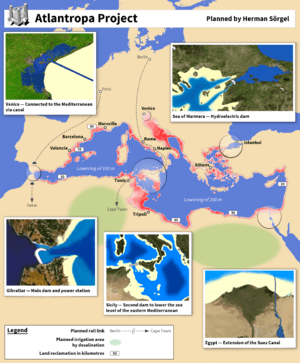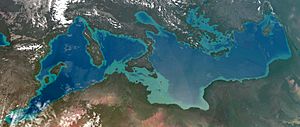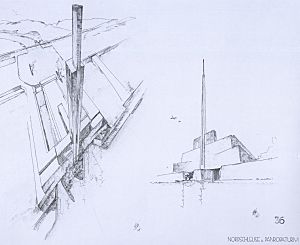Atlantropa facts for kids
Atlantropa, also called Panropa, was a huge engineering and settlement idea. It was thought up by a German architect named Herman Sörgel in the 1920s. He promoted it until he died in 1952. The plan involved building several hydroelectric dams in important parts of the Mediterranean Sea. These included the Strait of Gibraltar and the Bosporus. The goal was to lower the sea level and create lots of new land for people to live on. It was suggested as a peaceful way for European countries to work together.
What Was the Design?
The main part of Atlantropa was a giant hydroelectric dam across the Strait of Gibraltar. This dam would make huge amounts of electricity. It would also lower the Mediterranean Sea by up to 200 meters (about 650 feet). This would uncover large areas of new land, for example, in the Adriatic Sea.
The project also planned for four other big dams:
- Across the Dardanelles to hold back the Black Sea.
- Between Sicily and Tunisia to create a road and lower the inner Mediterranean even more.
- On the Congo River to refill a large area around Lake Chad. This would provide fresh water to grow crops in the Sahara Desert. It would also create a shipping route into Africa.
- An extension of the Suez Canal with locks to keep a connection to the Red Sea.
Sörgel believed his plan would take over 100 years to finish. He saw it as a peaceful way for Europe to unite. It was an alternative to ideas of taking over new lands by force. Atlantropa would offer land, food, jobs, and electric power. Most importantly, it would give Europe and nearby Africa a new shared goal.
The Atlantropa idea had four main constant themes:
- Peace: It promised to use technology for peaceful purposes.
- European Unity: It aimed to bring a war-torn Europe together.
- Focus on Europe: It saw Africa as a place to be joined with Europe, creating "Atlantropa" or Eurafrica.
- New World Order: It imagined the world divided into three big areas: America, Asia, and Atlantropa.
Only architects and planners, mostly from Germany and other Northern European countries, actively supported it. Some critics said it was bad because Mediterranean countries weren't involved in the planning. They also worried about how it would affect old coastal towns. These towns would be left far from the sea if the water level dropped. The project was very popular in the late 1920s and early 1930s. It became popular again briefly after World War II. But it faded away after Sörgel died.
How Did the Idea Start?
The plan was inspired by a geological event from 5 to 6 million years ago. This event is called the Messinian salinity crisis. During that time, the Mediterranean Sea was partly cut off from the Atlantic Ocean. This caused the sea level to drop a lot, leaving behind large salt deposits. Scientists today believe the Mediterranean's water level dropped by hundreds of meters during that period.
Sörgel's big goal was to solve Europe's major problems by creating a new continent. He called it "Atlantropa," and it would combine Europe and Africa. He thought Europeans would live there. Sörgel believed that for Europe to stay strong against America and a rising Asia, it needed to be self-sufficient. This meant having land in all climate zones. He thought a combined European effort to settle Africa was necessary.
Lowering the Mediterranean Sea would create huge amounts of electric power. This would help industries grow. Unlike fossil fuels, this power source would never run out. Vast areas of land would become available for farming. This included the Sahara Desert, which would be watered by three man-made lakes in Africa. The massive construction work would last over a century. It would create many jobs and help with too many people. Sörgel thought these were the main reasons for unrest in Europe.
He also believed the project would improve the climate. He even thought it could make winters warmer as far away as the British Isles. This would happen because the Gulf Stream would work better.
Sörgel and his supporters created many drawings and models for Atlantropa. These showed plans for dams, new ports, and even a 400-meter (1,300-foot) tower on the Gibraltar dam. They also showed how farming would grow and plans for a power grid across Atlantropa. They even had ideas to protect Venice as a cultural landmark. Concerns about climate change or earthquakes were seen as good things, not problems.
After World War II, people became interested in Atlantropa again. Western countries wanted to build stronger ties with their colonies in Africa. But then nuclear power was invented. Also, the cost of rebuilding after the war and the end of colonialism made Atlantropa seem unnecessary and too difficult to achieve. The Atlantropa Institute, which promoted the idea, closed in 1960.
Most ideas since then to build a dam in the Strait of Gibraltar focus only on making electricity. They don't plan to lower the Mediterranean Sea level. A newer idea involves a special fabric dam in the Strait of Gibraltar. This dam would help deal with any future rise in global sea levels outside the Mediterranean.
See also
 In Spanish: Atlantropa para niños
In Spanish: Atlantropa para niños




